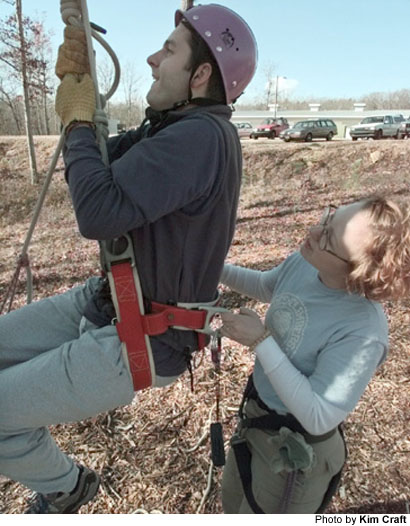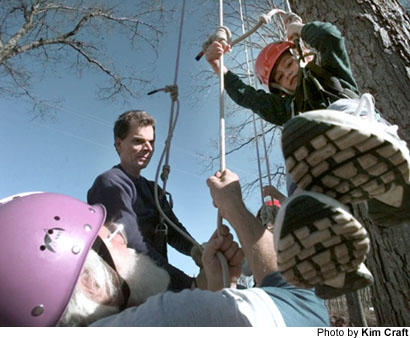
December 21, 1999 — My apologies to poet Joyce Kilmer, but …
I think that I shall never see
A column as lovely as a tree.
I wasn’t sure what to wear for my tree climbing lesson at the Chicopee Woods Agricultural Center last week. I used to wear Toughskins when I climbed as a child. I don’t think they’d fit anymore.
I wasn’t sure what to expect, either, and the many long white ropes dangling from the tall white oaks at Chicopee told me this wasn’t going to be at all similar to the climbs of my Toughskins youth.
But, we all were assured, none of that mattered.
“You don’t have to know squat about any of this,” Abram Winters told us from the beginning. “All of a sudden it just starts happening. And the next thing you know you’re four feet off the ground. And then you’re 20 feet off the ground.”
There were 15 or so of us, curious climbers-to-be, seated before Winters in the shade of a tall tree. And I don’t think there was one of us who doubted him.
Christmas was just days away and the 56-year-old Winters — with his snow-white beard and bowl-full-of-jelly laugh — looked just like a jolly old soul we all knew and loved.
Winters (if that’s his real name) is director of The Vision of E.Y.E., a recreational tree climbing club in Fayetteville. The Vision of E.Y.E. is one of hundreds of clubs, or “groves,” worldwide to have spawned from Tree Climbing International, founded in 1983 in Atlanta by a gentleman named Peter Jenkins.
Winters’ daughter Hope, who works for TCI, was also at Chicopee, and the duo demonstrated the climbing method we all would be using.
It’s called the double-rope technique, and it’s kind of difficult to explain. But somehow — thanks to a harness, a foot loop and a Blake’s hitch, a self-belaying friction knot — it works.
“(The knot) goes up, it comes down,” Abram explained, “and when you’re not touching it, it will hold you in midair.”
Then, in groups of four and five, we took to the trees. More rope climbing than tree climbing, the process is deliberate and contemplative.
Put foot in loop, stand up, watch hitch knot move down.
Push knot up, push foot loop up, put foot in loop.

Again and again. Inch by inch. Foot by foot. And, Abram was right, before I knew it I was 20, 30, 40, 50 feet in the air, looking at the ground from a perch usually reserved for birds or squirrels.
“With this if you get tired you just hang out and lean back in the swing,” said Abram. “Then you get your strength back and go for it again.”
When I got just beneath my anchor point, the branch my rope was slung over, I hung out for a while. There were a couple fellow tree climbers hanging there too. And we talked.
There we were, three human beings dangling from branches some 60 feet above the ground, carrying on a conversation.
It’s amazing the amount of trust we place in knots.
When conversations end and it’s time to come down, all you need to do is put some pressure on the top of the hitch not. And the descent begins.
“It’s exhilarating and relaxing at the same time … if that makes sense,” said Shay Bomberger, 25, a Hall County extension agent and first-time climber.
Added her coworker, 29-year-old Wendi Pendergrass, “I felt so burdenless. You leave all you burdens down here on the ground.”
Such reactions are commonplace for Hope, who has taken all sorts of folks — young children, the elderly, paraplegics, the blind — climbing over the past six years.
“When you can climb a living creature and can feel it move in the wind, it’s wonderful,” said Hope, 26, of Newnan. “It changes everybody once they’ve gone.”
And there’s so much more to recreational tree climbing than the small amount we experienced during our short lesson, Abram said. There’s camping in the tops of trees, climbing trees along ridge lines thousands of feet high, climbing trees so high you need a radio to communicate with the ground below, traversing through the air from tree to tree.
It’s arboreal gymnastics.
“There’s something about being able to climb trees that are 1,100 years old,” mused Abram. “They’re still alive. They’re still doing their thing. It’s like being part of history. They’ll begin to talk to you when they’re that old.
“Philosophically, it’s a grand way to spend time.”
Then, with a wink of his eye and a twist of his head, Abram bid me farewell. And I headed back to the office with a story to tell. But I knew …
Columns are made by fools like me,
But only God can make a tree.
